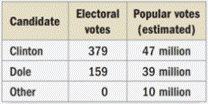
Concept explainers
a.
To calculate: which candidate’s percent of popular votes greater than the electoral votes.
a.
Answer to Problem 29E
Dole’s popular votes are greater than electoral votes.
Explanation of Solution
Given information: In a presidential election, the candidate who receives most popular votes in a state usually receives the state's electoral votes. In the 1996 election, about 96 million popular votes were cast and 538 electoral votes were cast.
The table shows the voting results from the election,

Calculation:
For Clinton,
Percent of electoral votes,
Percent of popular votes,
For Dole,
Percent of electoral votes,
Percent of popular votes,
Compare all the above values.
Hence, Dole’s popular votes is greater than electoral votes
b.
To calculate: whether the election was closer with respect to popular votes or electoral votes.
b.
Answer to Problem 29E
The election was closer with respect to popular votes.
Explanation of Solution
Given information: In a presidential election, the candidate who receives most popular votes in a state usually receives the state's electoral votes. In the 1996 election, about 96 million popular votes were cast and 538 electoral votes were cast.
The table shows the voting results from the election,

Calculation:
From part a.,
Percent of electoral votes for Clinton = 70.44%
Percent of electoral votes for Dole = 29.55%
The difference between Clinton and Dole with respect to electoral votes,
Percent of popular votes for Clinton = 48.96%
Percent of popular votes for Dole = 40.68%
The difference between Clinton and Dole with respect to popular votes,
Therefore, the difference between Clinton and Dole is high with the electoral votes.
Hence, the election was closer with respect to popular votes.
Chapter 7 Solutions
ELEMENTARY+INTERMEDIATE ALGEBRA
Additional Math Textbook Solutions
Calculus: Early Transcendentals (2nd Edition)
A First Course in Probability (10th Edition)
Precalculus
Algebra and Trigonometry (6th Edition)
A Problem Solving Approach To Mathematics For Elementary School Teachers (13th Edition)
- Safari File Edit View History Bookmarks Window Help Ο Ω OV O mA 0 mW ర Fri Apr 4 1 222 tv A F9 F10 DII 4 F6 F7 F8 7 29 8 00 W E R T Y U S D பட 9 O G H J K E F11 + 11 F12 O P } [arrow_forwardSo confused. Step by step instructions pleasearrow_forwardIn simplest terms, Sketch the graph of the parabola. Then, determine its equation. opens downward, vertex is (- 4, 7), passes through point (0, - 39)arrow_forward
- In simplest way, For each quadratic relation, find the zeros and the maximum or minimum. a) y = x 2 + 16 x + 39 b) y = 5 x2 - 50 x - 120arrow_forwardIn simplest terms and step by step Write each quadratic relation in standard form, then fi nd the zeros. y = - 4( x + 6)2 + 36arrow_forwardIn simplest terms and step by step For each quadratic relation, find the zeros and the maximum or minimum. 1) y = - 2 x2 - 28 x + 64 2) y = 6 x2 + 36 x - 42arrow_forward
- Write each relation in standard form a)y = 5(x + 10)2 + 7 b)y = 9(x - 8)2 - 4arrow_forwardIn simplest form and step by step Write the quadratic relation in standard form, then fi nd the zeros. y = 3(x - 1)2 - 147arrow_forwardStep by step instructions The path of a soccer ball can be modelled by the relation h = - 0.1 d 2 + 0.5 d + 0.6, where h is the ball’s height and d is the horizontal distance from the kicker. a) Find the zeros of the relation.arrow_forward
 Algebra and Trigonometry (6th Edition)AlgebraISBN:9780134463216Author:Robert F. BlitzerPublisher:PEARSON
Algebra and Trigonometry (6th Edition)AlgebraISBN:9780134463216Author:Robert F. BlitzerPublisher:PEARSON Contemporary Abstract AlgebraAlgebraISBN:9781305657960Author:Joseph GallianPublisher:Cengage Learning
Contemporary Abstract AlgebraAlgebraISBN:9781305657960Author:Joseph GallianPublisher:Cengage Learning Linear Algebra: A Modern IntroductionAlgebraISBN:9781285463247Author:David PoolePublisher:Cengage Learning
Linear Algebra: A Modern IntroductionAlgebraISBN:9781285463247Author:David PoolePublisher:Cengage Learning Algebra And Trigonometry (11th Edition)AlgebraISBN:9780135163078Author:Michael SullivanPublisher:PEARSON
Algebra And Trigonometry (11th Edition)AlgebraISBN:9780135163078Author:Michael SullivanPublisher:PEARSON Introduction to Linear Algebra, Fifth EditionAlgebraISBN:9780980232776Author:Gilbert StrangPublisher:Wellesley-Cambridge Press
Introduction to Linear Algebra, Fifth EditionAlgebraISBN:9780980232776Author:Gilbert StrangPublisher:Wellesley-Cambridge Press College Algebra (Collegiate Math)AlgebraISBN:9780077836344Author:Julie Miller, Donna GerkenPublisher:McGraw-Hill Education
College Algebra (Collegiate Math)AlgebraISBN:9780077836344Author:Julie Miller, Donna GerkenPublisher:McGraw-Hill Education





